Pope Boniface VI was the bishop of Rome and ruler of the Papal States in April 896. He was a native of Rome. His election came about as a result of riots soon after the death of Pope Formosus. Prior to his reign, he had twice incurred a sentence of deprivation of orders as a subdeacon and as a priest. After a pontificate of fifteen days, he is said by some to have died of the gout, by others to have been forcibly ejected to make way for Stephen VI, the candidate of the Spoletan party.

The Boletales are an order of Agaricomycetes containing over 1300 species with a diverse array of fruiting body types. The boletes are the best known members of this group, and until recently, the Boletales were thought to only contain boletes. The Boletales are now known to contain distinct groups of agarics, puffballs, and other fruiting-body types.

Suillus is a genus of basidiomycete fungi in the family Suillaceae and order Boletales. Species in the genus are associated with trees in the pine family (Pinaceae), and are mostly distributed in temperate locations in the Northern Hemisphere, although some species have been introduced to the Southern Hemisphere.
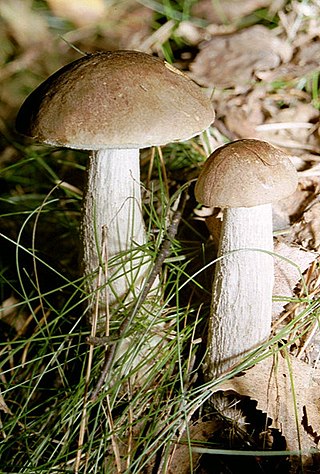
Leccinum scabrum, commonly known as the rough-stemmed bolete, scaber stalk, and birch bolete, is an edible mushroom in the family Boletaceae, and was formerly classified as Boletus scaber. The birch bolete is widespread in Europe, in the Himalayas in Asia, and elsewhere in the Northern Hemisphere, occurring only in mycorrhizal association with birch trees. It fruits from June to October. This mushroom is also becoming increasingly common in Australia and New Zealand where it is likely introduced.
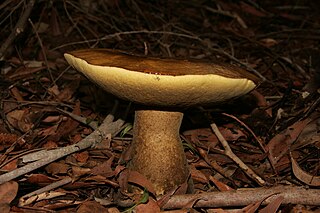
Phlebopus marginatus, commonly known as the salmon gum mushroom in Western Australia, is a member of the Boletales or pored fungi. An imposing sight in forests of south-eastern and south-western Australia, it is possibly Australia's largest terrestrial mushroom, with the weight of one specimen from Victoria recorded at 29 kg (64 lb). Initially described in 1845 as Boletus marginatus, and also previously known by scientific names such as Phaeogyroporus portentosus and Boletus portentosus, it is not as closely related to typical boletes as previously thought.
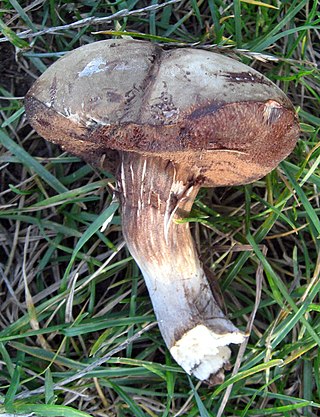
Porphyrellus is a genus of fungi of the family Boletaceae.
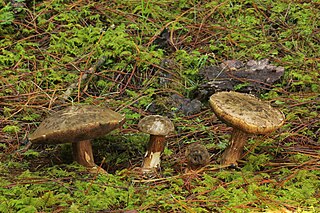
Porphyrellus porphyrosporus, commonly known as the dusky bolete, is a rare fungus belonging to the family Boletaceae. With its purple-brown cap and stem, P. porphyrosporus is not easy to spot, despite its large size. This summer and autumn species occurs under pines, but can also be found beneath deciduous trees. It is a large brown bolete. Its most distinctive features are the purple-brown spore print and the blue-green colour of the flesh at the top of the stem and above the hymenium.

Xerocomus subtomentosus, commonly known as suede bolete, brown and yellow bolete , boring brown bolete or yellow-cracked bolete, is a species of bolete fungus in the family Boletaceae. The fungus was initially described by Carl Linnaeus in 1753 and known for many years as Boletus subtomentosus. It is edible, though not as highly regarded as other bolete mushrooms.

Spongiforma thailandica is a species of fungus in the family Boletaceae, genus Spongiforma. The stemless sponge-like species, first described in 2009, was found in Khao Yai National Park in central Thailand, where it grows in soil in old-growth forests. The rubbery fruit body, which has a strong odor of coal-tar similar to Tricholoma sulphureum, consists of numerous internal cavities lined with spore-producing tissue. Phylogenetic analysis suggests the species is closely related to the Boletaceae genera Porphyrellus and Strobilomyces.
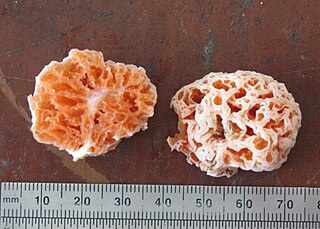
Spongiforma is a genus of sponge-like fungi in the family Boletaceae. Newly described in 2009, the genus contains two species: S. thailandica and S. squarepantsii. The type species S. thailandica is known only from Khao Yai National Park in central Thailand, where it grows in soil in old-growth forests dominated by dipterocarp trees. The rubbery fruit bodies, which has a strong odour of coal-tar similar to Tricholoma sulphureum, consists of numerous internal cavities lined with spore-producing tissue. S. squarepantsii, described as new to science in 2011, is found in Malaysia. It produces sponge-like, rubbery orange fruit bodies with a fruity or musky odour. These fruit bodies will—like a sponge—resume their original shape if water is squeezed out. The origin of the specific name derives from its perceived resemblance to the cartoon character SpongeBob SquarePants. Apart from differences in distribution, S. squarepantsii differs from S. thailandica in its colour, odour, and spore structure.

Tylopilus alboater, called the black velvet bolete, by some, is a bolete fungus in the family Boletaceae. The species is found in North America east of the Rocky Mountains, and in eastern Asia, including China, Japan, Taiwan, and Thailand. A mycorrhizal species, it grows solitarily, scattered, or in groups on the ground usually under deciduous trees, particularly oak, although it has been recorded from deciduous, coniferous, and mixed forests.

Xerocomellus is a genus of fungi in the family Boletaceae. The genus, as it was described in 2008, contained 12 species. However X. rubellus and X. engelii were transferred to the new genus Hortiboletus and X. armeniacus was transferred to the new genus Rheubarbariboletus in 2015. Molecular analysis supports the distinction of Xerocomellus species from Boletus and Xerocomus, within which these species were formerly contained. Xerocomellus in fact is only distantly related to Xerocomus and is most closely related to Tylopilus, Boletus sensu stricto, Porphyrellus, Strobilomyces, and Xanthoconium.
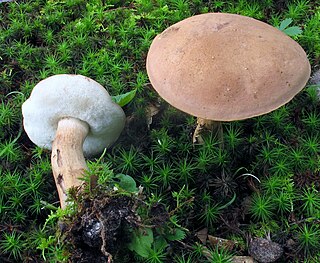
Porphyrellus indecisus is a bolete fungus in the family Boletaceae native to North America. It was described in 1888 by Charles Horton Peck.

Austroboletus gracilis is a species of bolete fungus in the family Boletaceae. Originally described as Boletus gracilis by Charles Horton Peck in 1872, it was transferred to the genus Austroboletus by Carl B. Wolfe in 1979.

Austroboletus rarus is a species of bolete fungus in the family Boletaceae. Found in Singapore and Australia, it was described as new to science by E.J.H. Corner in 1972, who called it Boletus rarus. Corner found the type collection growing on a forest floor in Bukit Timah in December 1940. He suggested that it might be a variety of Boletus rubiicolor. Egon Horak transferred it to the genus Austroboletus in 1980.

Porphyrellus sordidus is a bolete fungus in the family Boletaceae. It was originally described in 1874 by Charles Christopher Frost as a species of Boletus. Fruit bodies of the fungus have a convex to flattened cap measuring 4.5–13 cm (1.8–5.1 in) in diameter. The brownish cap surface is initially tomentose to felt-like, but develops cracks in age. All parts of the mushrooms bruise dark blue to greenish when injured. The spore print is reddish brown; spores are smooth, roughly elliptical, and measure 10–14 by 4–6 µm. The bolete is found in North America, where it grows on the ground under oaks and conifers. Its edibility was recently unknown, but it is now considered inedible.

Porphyrellus brunneus is a bolete fungus of the genus Tylopilus found in New Zealand. It was originally described by Robert Francis Ross McNabb in 1967.

Austroboletus subflavidus is a species of bolete fungus in the family Boletaceae. It is found in eastern North America, where it fruits near oak and pine trees. Originally described as a species of Tylopilus by American mycologist William Murrill in 1938, it was transferred to the genus Austroboletus by Carl B. Wolfe in 1980. The fruit body has a white to yellowish convex to flattened cap measuring 3–10 cm (1.2–3.9 in) in diameter. The pores on the cap underside, which measure about 1 mm wide, are initially white to grayish before becoming pinkish. The coarsely reticulate and pitted stipe measures 4.5–14.5 cm (1.8–5.7 in) long by 0.7–3 cm (0.3–1.2 in). The spore print is reddish brown; spores are spindle-shaped (fusoid) with dimensions of 15–20 by 6–9 μm.

















